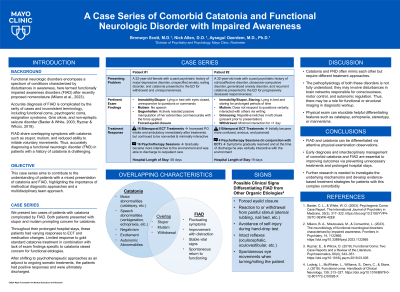Catatonia
(014) A Case Series of Comorbid Catatonia and Functional Neurologic Disorder with Impaired Awareness


Bronwyn Scott, MD
Resident Physician
Mayo Clinic
Rochester, Minnesota.jpg)
Nicholas Allen, MD
Consultant
Mayo Clinic
Rochester, Minnesota
Aysegul Ozerdem, MD, PhD
Consultant
Mayo Clinic
Rochester, Minnesota
Presenting Author(s)
Co-Author(s)
Background/Significance:
Functional neurologic disorders encompass a spectrum of conditions characterized by disturbances in awareness, here termed functionally impaired awareness disorders (FIAD) after recently proposed nomenclature (Milano et al., 2023). Accurate diagnosis of FIAD is complicated by the rarity of cases and inconsistent terminology used in the literature, including functional coma, psychogenic coma, resignation syndrome, Grisi siknis, and non-epileptic seizure disorder (Baxter & White, 2003; Ryznar & Wilcox, 2019; Sallin et al., 2016). Moreover, FIAD share overlapping symptoms with catatonia such as stupor, mutism, and reduced ability to initiate voluntary movements. Thus, accurately diagnosing a functional neurologic disorder (FND) in patients with a history of catatonia is particularly challenging. This case series aims to contribute to the understanding of patients with a history of catatonia who present with FIAD, highlighting the importance of methodical diagnostic approaches and a multidisciplinary team approach.
Case Series:
We present two cases of patients with catatonia complicated by FIAD. Both patients presented with stupor and mutism prompting concern for catatonia and subsequent electroconvulsive therapy (ECT) treatments. Throughout their prolonged hospital stays, these patients had varying responses to ECT and medication changes. Limited response to gold standard catatonia treatment in combination with lack of exam findings specific to catatonia raised concern for functional etiologies. After shifting to psychotherapeutic approaches as an adjunct to ongoing somatic treatments, the patients had positive responses and were ultimately able to discharge.
Discussion:
The coexistence of catatonia and FND poses diagnostic and therapeutic challenges as symptoms often mimic each other but require different treatment approaches. The pathophysiology of both these disorders is not fully understood; however, both may involve disturbances in brain networks responsible for consciousness, motor control, and autonomic regulation. Physical exam can elucidate helpful differentiating features, such as lack of characteristic signs of catatonia (e.g., catalepsy, echopraxia, stereotypy, or mannerisms). While an empiric approach to treatment is a clinical practicality, these cases highlight the need for further study to optimize care in the future.
Conclusion/Implications:
This case series highlights the importance of recognizing comorbid catatonia and FIAD. Early diagnosis and interdisciplinary management are essential to improve outcomes. Further research is needed to investigate the underlying mechanisms and develop evidence-based treatment strategies for patients with this complex presentation.
References
Baxter, C. L., & White, W. D. (2003). Psychogenic Coma: Case Report. The International Journal of Psychiatry in Medicine, 33(3), 317–322. https://doi.org/10.2190/YVP4-3GTC-0EWK-42E8
Milano, B. A., Moutoussis, M., & Convertino, L. (2023). The neurobiology of functional neurological disorders characterised by impaired awareness. Frontiers in Psychiatry, 14, 1122865. https://doi.org/10.3389/fpsyt.2023.1122865
Ryznar, E., & Wilcox, D. (2019). Functional Coma: Two Case Reports and a Review of the Literature. Psychosomatics, 60(4), 343–351. https://doi.org/10.1016/j.psym.2019.03.005
Sallin, K., Lagercrantz, H., Evers, K., Engström, I., Hjern, A., & Petrovic, P. (2016). Resignation Syndrome: Catatonia? Culture-Bound? Frontiers in Behavioral Neuroscience, 10. https://doi.org/10.3389/fnbeh.2016.00007
Presentation Eligibility: Not previously published or presented
Diversity, Equity, and Inclusion: Patients with functional neurologic disorders characterized by impaired awareness and catatonia are not able to advocate for themselves. Thus, it is important to accurately diagnose and treat this population. Although the cases presented here feature individuals from Caucasian backgrounds, there is some evidence that suggests a higher prevalence of functional neurologic disorders in sexual and gender minorities who would benefit from advancing our understanding of the nuances differentiating catatonia from functional neurologic disorders.

